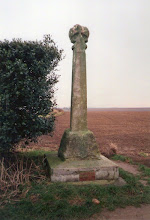Tuesday 24 August 2010
Proceedings of the Society of Antiquaries of Scotland
This journal is a good source for archaeological and historical works relevant to studying and depicting the Picts and I have just discovered that PDFs of Vols. 1 (1852) to 102 (2002) are available online here: http://ads.ahds.ac.uk/cfm/archway/volumeSelector.cfm?rcn=1340
Some examples of the breadth of imagery of the Picts: contemporary; historical and modern ...



How the Picts depicted themselves:

A stone slab from Bullion, Invergowrie, Angus, Scotland (discovered in 1934) which Laing and Laing (1984) argue may date from the Eighth century CE because of the similarity of the bird's head terminal on the drinking horn to those in the Lindisfarne Gospels. (Source: Lloyd Laing and Jennifer Laing, 'Archaeological notes on some Scottish early Christian Sculptures,' Proceedings of the Society of Antiquaries of Scotland, 114 (1984), 277–287, p. 286)
Romantic images of the Picts:

Modern depictions (!):

Thursday 15 July 2010
Avast ye sticky swab ...
I can't resist a bit of fatherly bragging by offering a peek of the first miniature my daughter has painted. She has wanted to paint 'knights' with me for a long time now so I gave her a handful of Eureka Miniatures wonderful Teddy Bear Pirates for her seventh birthday, recently.
This was her first bear - painted immediately after she opened the parcel.
This was her first bear - painted immediately after she opened the parcel.
 |
| A sticky swab indeed! |
Thursday 27 May 2010
Its all about me!
Well, this is my first foray into blogging. I'm a little uncomfortable with the medium feeling it to be a little self-centered to think that anyone else would care for my online ramblings. However, with that caveat, here I go ...
Learn more about DBA at this fantastic website: Fanaticus
I have the following armies under construction and will post images as they are completed:
- Anglo-Danish, 1014–1075 CE (III/71)
- Norman / West Frankish, 888–1072 CE (III/51)
- Norse Viking, 790–1280 CE (III/40)
- Teutonic Orders, 1201–1522 CE (IV/30)
- Low Countries, 1297–1478 CE (IV/57)
- Medieval French, 1330–1445 CE (IV/64)
- Later Swiss, 1400–1522 (IV/79)
- Wars of the Roses English (Yorkist), 1455–1487 CE (IV/83)
My first attempts at DBA armies some years ago also leave me with two armies of late antiquity that are gathering dust in the cupboard (although, not entirely unloved!).
- Ancient British, 55 BCE–75 CE (II/53)
- Early Imperial Roman, 25 BCE–197 CE (II/56)
Subscribe to:
Posts (Atom)

